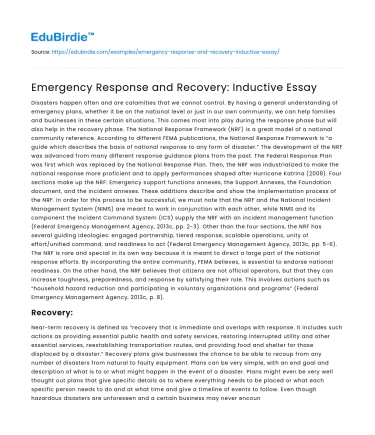Disasters happen often and are calamities that we cannot control. By having a general understanding of emergency plans, whether it be on the national level or just in our own community, we can help families and businesses in these certain situations. This comes most into play during the response phase but will also help in the recovery phase.
The National Response Framework (NRF) is a great model of a national community reference. According to different FEMA publications, the National Response Framework is “a guide which describes the basis of national response to any form of disaster.” The development of the NRF was advanced from many different response guidance plans from the past. The Federal Response Plan was first which was replaced by the National Response Plan. Then, the NRF was industrialized to make the national response more proficient and to apply performances shaped after Hurricane Katrina (2008). Four sections make up the NRF: Emergency support functions annexes, the Support Annexes, the Foundation document, and the Incident annexes. These additions describe and show the implementation process of the NRF. In order for this process to be successful, we must note that the NRF and the National Incident Management System (NIMS) are meant to work in conjunction with each other, while NIMS and its component the Incident Command System (ICS) supply the NRF with an incident management function (Federal Emergency Management Agency, 2013c, pp. 2-3). Other than the four sections, the NRF has several guiding ideologies: engaged partnership, tiered response, scalable operations, unity of effort/unified command, and readiness to act (Federal Emergency Management Agency, 2013c, pp. 5-6).
Save your time!
We can take care of your essay
- Proper editing and formatting
- Free revision, title page, and bibliography
- Flexible prices and money-back guarantee
The NRF is rare and special in its own way because it is meant to direct a large part of the national response efforts. By incorporating the entire community, FEMA believes, is essential to endorse national readiness. On the other hand, the NRF believes that citizens are not official operators, but that they can increase toughness, preparedness, and response by satisfying their role. This involves actions such as “household hazard reduction and participating in voluntary organizations and programs” (Federal Emergency Management Agency, 2013c, p. 8).
Recovery:
Near-term recovery is defined as “recovery that is immediate and overlaps with response. It includes such actions as providing essential public health and safety services, restoring interrupted utility and other essential services, reestablishing transportation routes, and providing food and shelter for those displaced by a disaster.” Recovery plans give businesses the chance to be able to recoup from any number of disasters from natural to faulty equipment. Plans can be very simple, with an end goal and description of what is to or what might happen in the event of a disaster. Plans might even be very well thought out plans that give specific details as to where everything needs to be placed or what each specific person needs to do and at what time and give a timeline of events to follow.
Even though hazardous disasters are unforeseen and a certain business may never encounter such tragic harsh times, or even have to implement their plans, it allows them to be prepared and possibly succeed if a disaster were to strike and not completely be hopeless and not have an opportunity to redeem themselves.
California is known for its hazardous wildfires. San Diego County especially, has faced some of the most devastating firestorms in the last two decades. Ron Roberts, chairman of the San Diego County Board of Supervisors, describes the county’s disposition as, 'We have a very dangerous, unpredictable situation. We have some of the highest temperatures, some of the driest landscape conditions, and some of the most powerful winds - all ingredients for a perfect firestorm (Pesce, 2007).'
Taking it back some years to 2003 when the Cedar fire struck the beautiful San Diego. The Cedar Fire was the worst in State history at that time (2003). Then in 2007, devastation struck again in San Diego and this time much worse than Cedar. (Ekard, Tuck, Jr., & Steffen, 2003). At this point, San Diego had practiced managing these firestorms with their response actions. There were many lessons learned from the 2003 fire and improvements were implemented effectively in 2007. Wildfires are foreseeable due to the drought in California, winds from Santa Ana, climate changes, and human behavior (Pesce). In order to mitigate the degree of life lost and property damage in a disaster such as this, there needs to be a very effective and well-thought-out Incident Command System (ICS), with trained personnel to execute the plan. Response plans will designate responsibilities, and roles, and show models with instructions for procedures never done before. Every time these procedures are played out, it gives the people the chance to readdress and improve to have a better outcome.
San Diego was struck with three massive fires, Paradise, Otay, and Cedar followed instantaneously. The Cedar fire did most of the work, consumed 2,400 homes, took 16 lives and a firefighter, and burned through about 376000 acres. (SDSU) Tim Turner, San Diego Area Coordination Team, reported “The Cedar Fire burned 80,000 acres in 10 hours. That’s over two acres per second.” The greatness and immensely altering features of these fires put into perception the huge job the County was facing as to why so many ICS factors had failed.






 Stuck on your essay?
Stuck on your essay?

